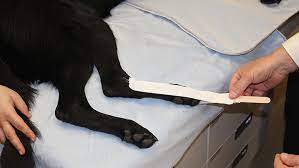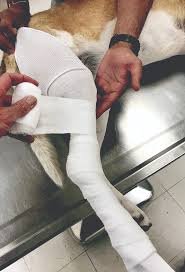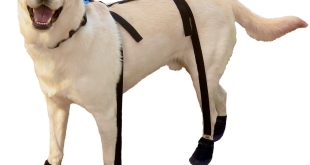Knuckling over is a term used to describe Carpal Laxity Syndrome which can be a case of hyperextension or hyperflexion deformity. This problem mainly affects large breed puppies who are below 4 months.
Your pup may be unilaterally or bilaterally affected, and this means it can affect just one of its front legs or both of them.
While all dog breeds can be affected, larger dogs tend to be more prone to having this syndrome compared to smaller dog breeds
The cause is not known but may be related to unbalanced growth, poor muscle tone, or weakness between the flexor and extensor muscle groups. Improper exercise, poor footing (eg, slippery surfaces), inappropriate nutrition, and genetics have also been recognized as factors.
Splints and Bandages

In cases of knuckling over, you may have to wrap your dog’s leg(s) in splints and bandages.
This is required to support the bone to facilitate correction while minimizing any further damage.
Although, some vets will ask for your dog to be left without splints but restricted to a safe area (not a crate or pen) with appropriate flooring which your pup can grip. This is done with hope that the condition will rectify on it’s own between 2 – 4 weeks.
Whereas other vets, will advise the use of a splint for anywhere between 7-10 days to help the condition resolve quickly.
Note that long term use of splints is not appropriate unless absolutely necessary as it may result in muscle atrophy.
Also, splints can sometimes be tricky to keep on and some dogs may bite at the bandages keeping the splints in place.
As a dog owner, it’s important to know how to wrap your pup’s leg especially in cases where your pup bites off the bandage very often and displaces the splint.
Step by Step Instructions in How to Wrap Pup’s Leg for Knuckling Over

So here’s how you can wrap your pup’s leg in cases of knuckling over.
The first thing to do after confirming that your dog needs a splint is to get the required materials; cotton padding bandage/Soffban, cotton bandage, zinc oxide tape, crepe bandage (preferably a self-adhesive bandage), adhesive bandage and a splint that is a similar width and as long as the affected limbs.
Then follow these steps we will show you how to do a standard Vet Wrap for dogs who with Knuckling;
Vet Wrap for Knuckling
Step 1
- Move your dog to a calm place – this will keep away all sorts of distractions so you can fix the wrap successfully.
- Get your dog to lay still on a comfortable surface so you can assess the affected area(s).
- Now you can start by applying the first protective layer using some rolls of Soffban, and some rolls of cotton bandage.
- When fixing the splint, you want to prevent the splint from resting against your dog’s skin because this can cause pain or injury.
Step 2
You can ask someone to assist you in holding your dog still as this will prevent your dog from shaking off the dressing halfway through.
Place the splint against the padding to support the affected leg(s). Make sure you line up the splint to properly fit the area.
- Secure the splint in place with the zinc oxide tape by placing the strips one at each end of the splint and then throughout the splint.
Wind the tape around the splint and cotton bandage, so the splint is secured firmly against the limb.
Step 3
If you don’t have a zinc oxide tape handy, you can improvise with what you have. So alternatives like sticky tape, duct tape, or even shoelaces tied around the splint and leg to secure it in place work well. The goal is to anchor the splint against the leg so it is comfortable for your dog.
- Fix another layer of Soffban. Do this the same way you placed the initial layer of the Soffban.
Then, wind a layer of cotton bandage over the top of the Soffban, using the same method.
- Repeat this for approximately 2-3 layers by adding further layers of padding and bandage to hold the splint in place.
- Now place a protective layer such as crepe bandage to keep the bandage clean and rigid. Don’t stretch the co-flex as it can contract and impair blood circulation.
Step 4
If you do not have access to a crepe bandage, don’t worry about this step. The bandage will be fine without an outer layer in the short term (about a day).
This outer layer is meant to keep the inner layers clean, which becomes important since the dressing has to stay in place for several days.
- Finally, secure the splint from sliding off with an adhesive dressing – it is best to use one that doesn’t stick to your pet’s fur. Cut a length of the adhesive dressing that is long enough to pass twice around the top of the dressing.
Dogs love to jump, run and play, so in order to keep your pooch’s splint in place, these steps have to be carefully followed.
Consider this a temporary tool with multiple uses to help correct gait.
Also, here are some additional things you can do to help your pup with knuckling over:
Sometimes, a balanced diet and gentle exercise is enough to reverse this problem.
In cases where your pooch struggles to walk, penning/crating may seem appropriate and it is generally recommended that your dog still moves about on only appropriate surfaces where your dog can have a good grip.
Conclusion
Although this condition is generally self-limiting, affected puppies should only ever be on surfaces they can grip, this means they should not be slippery surfaces such as floorboards, etc.
Taking an affected puppy on a walk is not appropriate nor is physical play. The only exercises you should subject your pup to are those recommended by your vet.
Your pooch should be kept on surfaces such as carpet, rubber mats, and grass they can easily grip.
You should ensure you are not overfeeding your dog because growing your dog in a lean state is very crucial to resolving carpal laxity syndrome.
Choose a high-quality diet and avoid low-quality supermarket dry & tinned foods.
While it’s important to avoid giving your dog calcium supplements, you may also consult your vet for some supplement recommendations that will be beneficial to your pooch.
 Total Pooch Dog Supplements, Tear Stain Removers, De-wormers, Tylosin for Dogs and other great products.
Total Pooch Dog Supplements, Tear Stain Removers, De-wormers, Tylosin for Dogs and other great products.



